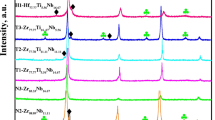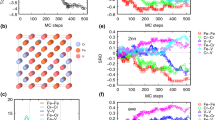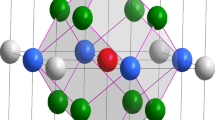Abstract
Refractory high-entropy alloys (RHEAs) with body-centered-cubic (BCC) structure are a new class of alloy materials and have great potential for high temperature applications. The present work investigated the BCC structural stabilities of Ti-Zr-Nb-Hf RHEAs with both first-principles calculations and experimental characterization. The cluster-plus-glue-atom model (cluster model) for the presentation of chemical short-range ordering (CSRO) in solid solutions was applied to construct the model input for the first-principles method, in which the density functional theory was used. Three cluster structural units were considered, [Ti-Hf14]Nb3, [Ti-Zr8Hf6]Nb3, and [Ti-Zr8Hf4Ti2]Nb3. The corresponding alloys were fabricated, and microstructural characterization was performed. The calculated results of the formation energies and free energies of these three alloys indicate that the [Ti-Zr8Hf4Ti2]Nb3 has the highest BCC structural stability due to its lowest formation energy and free energy. It is well consistent with the experimental observation, where the [Ti-Zr8Hf4Ti2]Nb3 alloy exhibits a single BCC structure without any precipitation, while a small amount of α and/or ω phases would precipitate from the BCC matrix in the other alloys. The cluster-model-embedded first-principles method could provide a new approach for accurate calculations.





Similar content being viewed by others
References
E.P. George, W.A. Curtin, and C.C. Tasan, High Entropy Alloys: A Focused Review of Mechanical Properties and Deformation Mechanisms, Acta Mater., 2020, 188, p 435–474.
J.W. Yeh, S.K. Chen, S.J. Lin, J.Y. Gan, T.S. Chin, T.T. Shun, C.H. Tsau, and S.Y. Chang, Nanostructured High-Entropy Alloys with Multiple Principal Elements: Novel Alloy Design Concepts and Outcomes, Adv. Eng. Mater., 2004, 6(5), p 299–303.
D.B. Miracle, and O.N. Senkov, A Critical Review of High Entropy Alloys and Related Concepts, Acta Mater., 2016, 122, p 488–511.
Y. Zhang, T.T. Zuo, Z. Tang, M.C. Gao, K.A. Dahmen, P.K. Liaw, and Z.P. Lu, Microstructures and Properties of High-Entropy Alloys, Prog. Mater. Sci., 2014, 61, p 1–93.
T. Yang, Y.L. Zhao, Y. Tong, Z.B. Jiao, J. Wei, J.X. Cai, X.D. Han, D. Chen, A. Hu, J.J. Kai, K. Lu, Y. Liu, and C.T. Liu, Multicomponent Intermetallic Nanoparticles and Superb Mechanical Behaviors of Complex Alloys, Science, 2018, 362(6417), p 933–937.
D.B. Miracle, High Entropy Alloys as a Bold Step Forward in Alloy Development, Nat. Commun., 2019, 10, p 1805.
E.P. George, D. Raabe, and R.O. Ritchie, High-Entropy Alloys, Nat. Rev. Mater., 2019, 4, p 515–534.
Y. Tong, S. Bai, and K. Chen, C/C–ZrC Composite Prepared by Chemical Vapor Infiltration Combined with Alloyed Reactive Melt Infiltration, Ceram. Int., 2012, 38(7), p 5723–5730.
O.N. Senkov, G.B. Wilks, D.B. Miracle, C.P. Chuang, and P.K. Liaw, Refractory High-Entropy Alloys, Intermetallics, 2010, 18, p 1758–1765.
H.W. Yao, J.W. Qiao, M.C. Gao, J.A. Hawk, S.G. Ma, H.F. Zhou, and Y. Zhang, NbTaV-(Ti, W) Refractory High-Entropy Alloys: Experiments and Modeling, Mater. Sci. Eng. A, 2016, 674, p 203–211.
M. Zhang, X. Zhou, X. Yu, and J. Li, Synthesis and Characterization of Refractory TiZrNbWMo High-Entropy Alloy Coating by Laser Cladding, Surf. Coat. Technol., 2017, 311, p 321–329.
M. Todai, T. Nagase, T. Hori, A. Matsugaki, A. Sekita, and T. Nakano, Novel TiNbTaZrMo High-Entropy Alloys for Metallic Biomaterials, Scripta Mater., 2017, 129, p 65–68.
H.L. Huang, Y. Wu, J.Y. He, H. Wang, X.J. Liu, K. An, W. Wu, and Z.P. Lu, Phase-Transformation Ductilization of Brittle High-Entropy Alloys via Metastability Engineering, Adv. Mater., 2017, 29(30), p 1701678.
L. Lilensten, J.P. Couzinié, L. Perrière, J. Bourgon, N. Emery, and I. Guillot, New Structure in Refractory High-Entropy Alloys, Mater. Lett., 2014, 132, p 123–125.
H. Song, F. Tian, Q.M. Hu, L. Vitos, Y. Wang, J. Shen, and N. Chen, Local Lattice Distortion in High-Entropy Alloys, Phy. Rev. Mater., 2017, 1(2), p 023404.
P. Yu, Y. Zhuang, J.P. Chou, J. Wei, Y.C. Lo, and A. Hu, The Influence of Dilute Aluminum and Molybdenum on Stacking Fault and Twin Formation in FeNiCoCr-Based High Entropy Alloys Based on Density Functional Theory, Sci. rep., 2019, 9(1), p 1–8.
Y. Mu, H. Liu, Y. Liu, X. Zhang, Y. Jiang, and T. Dong, An ab Initio and Experimental Studies of the Structure, Mechanical Parameters and State Density on the Refractory High-Entropy Alloy Systems, J. Alloy. Compd., 2017, 714, p 668–680.
B. Grabowski, Y. Ikeda, P. Srinivasan, F. Körmann, C. Freysoldt, A.I. Duff, A. Shappev, and J. Neugebauer, Ab Initio Vibrational Free Energies Including Anharmonicity for Multicomponent Alloys, npj Comput. Mater., 2019, 5(1), p 1–6.
L. Rogal, P. Bobrowski, F. Körmann, S. Divinski, F. Stein, and B. Grabowski, Computationally-Driven Engineering of Sublattice Ordering in a Hexagonal AlHfScTiZr High Entropy Alloy, Sci. Rep., 2017, 7(1), p 1–14.
R. Feng, P.K. Liaw, M.C. Gao, and M. Widom, First-principles Prediction of High-Entropy-Alloy Stability, npj Comput. Mater., 2017, 3(1), p 1–7.
L.Y. Tian, G. Wang, J.S. Harris, D.L. Irving, J. Zhao, and L. Vitos, Alloying Effect on the Elastic Properties of Refractory High-Entropy Alloys, Mater. Des., 2017, 114, p 243–252.
W.Y. Wang, S.L. Shang, Y. Wang, F. Han, K.A. Darling, Y. Wu, X. Xie, O.N. Senkov, J.S. Li, X.D. Hui, K.A. Dahmen, P.K. Liaw, L.J. Kecskes, and Z.K. Liu, Atomic and Electronic Basis for the Serrations of Refractory High-Entropy Alloys, npj Comput. Mater., 2017, 3(1), p 1–10.
H. Song, F. Tian, and D. Wang, Thermodynamic Properties of Refractory High Entropy Alloys, J. Alloy. Compd., 2016, 682, p 773–777.
A. Zunger, S.H. Wei, L.G. Ferreira, and J.E. Bernard, Special Quasirandom Structures, Phy. Rev. Lett., 1990, 65(3), p 35.
L. Vitos, Computational Quantum Mechanics for Materials Engineers: the EMTO Method and Applications. Springer Science & Business Media, Berlin, 2007.
R. Zhang, S. Zhao, J. Ding, Y. Chong, T. Jia, C. Ophus, M. Asta, R.O. Ritchie, and A.M. Minor, Short-Range Order and its Impact on the CrCoNi Medium-Entropy Alloy, Nature, 2020, 581(7808), p 283–287.
L.J. Santodonato, Y. Zhang, M. Feygenson, C.M. Parish, M.C. Gao, R.J. Weber, J.C. Neuefeind, Z. Tang, and P.K. Liaw, Deviation from high-entropy configurations in the atomic distributions of a multi-principal-element alloy, Nat. Commun., 2015, 6(1), p 1–13.
D.J. Ding, Q. Yu, M. Asta, and R.O. Ritchie, Tunable Stacking Fault Energies by Tailoring Local Chemical Order in CrCoNi Medium-Entropy Alloys, Proc. Natl. Acad. Sci., 2018, 115(36), p 8919–8924.
D. Sobieraj, J.S. Wróbel, T. Rygier, K.J. Kurzydłowski, O. El Atwani, A. Devaraj, E. Martinezsaez, and D. Nguyen-Manh, Chemical Short-Range Order in Derivative Cr–Ta–Ti–V–W High Entropy Alloys from the First-Principles Thermodynamic Study, Phys. Chem. Chem. Phys., 2020, 22(41), p 23929–23951.
S. Chen, Z.H. Aitken, S. Pattamatta, Z. Wu, Z.G. Yu, R. Banerjee, D.J. Srolovitz, P.K. Liaw, and Y. Zhang, Chemical-affinity Disparity and Exclusivity Drive Atomic Segregation, Short-Range Ordering, and Cluster Formation in High-Entropy Alloys, Acta Mater., 2021, 206, p 116638.
W. Guo, W. Dmowski, J. Noh, P. Rack, P.K. Liaw, and T. Egami, Local Atomic Structure of a High-Entropy Alloy: An x-ray and Neutron Scattering Study, Metall. Mater. Trans. A, 2013, 44(5), p 1994–1997.
P. Singh, A.V. Smirnov, and D.D. Johnson, Atomic Short-range Order and Incipient Long-range Order in High-Entropy Alloys, Phys. Rev. B, 2015, 91(22), p 224204.
Y. Ma, Q. Wang, C.L. Li, L.J. Santodonato, M. Feygenson, C. Dong, and P.K. Liaw, Chemical Short-Range Orders and the Induced Structural Transition in High-Entropy Alloys, Scripta Mater., 2018, 144, p 64–68.
F.Y. Tian, D.Y. Lin, X.Y. Gao, Y.F. Zhao, and H.F. Song, A Structural Modeling Approach to Solid Solutions Based on the Similar Atomic Environment, J. Chem. Phys., 2020, 153, p 034101.
J.W. Wu, Z. Yang, J.W. Xian, X.Y. Gao, D.Y. Lin, and H.F. Song, Structural and Thermodynamic Properties of the High-Entropy Alloy AlCoCrFeNi Based on First-Principles Calculations, Front. Mater, 2020, 7, p 590143.
A. Takeuchi, and A. Inoue, Classification of Bulk Metallic Glasses by Atomic Size Difference, Heat of Mixing and Period of Constituent Elements and its Application to Characterization of the Main Alloying Element, Mater. Trans., 2005, 46, p 2817–2829.
B.B. Jiang, Q. Wang, C. Dong, and P.K. Liaw, Exploration of Phase Structure Evolution Induced by Alloying Elements in Ti Alloys via a Chemical-Short-Range-Order Cluster Model, Sci. Rep., 2019, 9, p 3404–3411.
H.L. Hong, Q. Wang, C. Dong, and P.K. Liaw, Understanding the Cu-Zn Brass Alloys Using a Short-Range-Order Cluster Model: Significance of Specific Compositions of Industrial Alloys, Sci. Rep., 2014, 4, p 7065.
C. Pang, Q. Wang, R.Q. Zhang, Q. Li, X. Dai, C. Dong, and P.K. Liaw, Zr–Nb–Ti–Mo–Sn Alloys with Low Young’s Modulus and Low Magnetic Susceptibility Optimized via a Cluster-Plus-Glue-Atom Model, Mater. Sci. Eng. A, 2015, 626, p 369–374.
Y. Ma, Q. Wang, X.Y. Zhou, J.M. Hao, B. Gault, Q.Y. Zhang, C. Dong, and T.G. Nieh, Novel Soft-Magnetic B2-Based Multiprincipal-Element Alloy with a Uniform Distribution of Coherent Body-Centered-Cubic Nanoprecipitates, Adv. Mater., 2021, 33, p 2006723.
Y. Ma, Q. Wang, B.B. Jiang, C.L. Li, J.M. Hao, X.N. Li, C. Dong, and T.G. Nieh, Controlled Formation of Coherent Cuboidal Nanoprecipitates in Body-Centered Cubic High-Entropy Alloys Based on Al2(Ni Co, Fe, Cr)14 Compositions, Acta Mater., 2018, 147, p 213–225.
Q. Wang, J.C. Han, Y.F. Liu, Z.W. Zhang, C. Dong, and P.K. Liaw, Coherent Precipitation and Stability of Cuboidal Nanoparticles in Body-Centered-Cubic Al0.4Nb0.5Ta0.5TiZr0.8 Refractory High Entropy Alloy, Scripta Mater., 2021, 190, p 40–45.
Y. Okazaki, and E. Gotoh, Comparison of Metal Release from Various Metallic Biomaterials in vitro, Biomaterials, 2005, 26, p 11–21.
P. Giannozzi, S. Baroni, N. Bonini, M. Calandra, R. Car, C. Cavazzoni, D. Ceresoli, G.L. Chiarotti, M. Cococcioni, I. Dabo, A. Dal Corso, S. Fabris, G. Fratesi, S. deGironcoli, R. Gebauer, U. Gerstmann, C. Gougoussis, A. Kokalj, M. Lazzeri, L. Martin-Samos, N. Marzari, F. Mauri, R. Mazzarello, S. Paolini, A. Pasquarello, L. Paulatto, C. Sbraccia, S. Scandolo, G. Sclauzero, A.P. Seitsonen, A. Smogunov, P. Umari, and R.M. Wentzcovitch, QUANTUM ESPRESSO: A Modular and Open-Source Software Project for Quantum Simulations of Material, J. Phys.: Condens. Matter., 2009, 21, p 395502.
P. Giannozzi, O. Andreussi, T. Brumme, O. Bunau, M. Buongiornonardelli, M. Calandra, R. Car, C. Cavazzoni, D. Ceresoli, M. Cococcioni, N. Colonna, I. Carn-imeo, A. Dal Corso, S. de Gironcoli, P. Delugas, R.A. DiStasio Jr., A. Ferretti, A. Floris, G. Fratesi, G. Fugallo, R. Gebauer, U. Gerstmann, F. Giustino, T. Gorni, J. Jia, M. Kawamura, H.-Y. Ko, A. Kokalj, E. Kü,cükbenli, M. Lazzeri, M. Marsili, N. Marzari, F. Mauri, N.L. Nguyen, H.-V. Nguyen, A. Otero-de-la-Roza, L. Paulatto, S. Ponće, D. Rocca, R. Sabatini, B. Santra, M. Schlipf, A.P. Seitsonen, A. Smo-gunov, I. Timrov, T. Thonhauser, P. Umari, N. Vast, X. Wu, and S. Baroni, Advanced Capabilities for Materials Modelling with Quantum ESPRESSO, J Phys: Condens Matter, 2017, 29, p 465901.
G. Kresse, From Ultrasoft Pseudopotentials to the Projector Augmented-Wave Method, Phys. Rev. B, 1999, 59(3), p 1758–1775.
J.P. Perdew, K. Burke, and M. Ernzerhof, Generalized Gradient Approximation Made Simple, Phys. Rev. Lett., 1996, 77(18), p 3865.
Acknowledgments
It was supported by National Defense Basic Scientific Research Project (HTKJ2019KL703001) and the National Natural Science Foundation of China (No. 91860108).
Author information
Authors and Affiliations
Corresponding authors
Additional information
Publisher's Note
Springer Nature remains neutral with regard to jurisdictional claims in published maps and institutional affiliations.
This article is part of a special topical focus in the Journal of Phase Equilibria and Diffusion on the Thermodynamics and Kinetics of High-Entropy Alloys. This issue was organized by Dr. Michael Gao, National Energy Technology Laboratory; Dr. Ursula Kattner, NIST; Prof. Raymundo Arroyave, Texas A&M University; and the late Dr. John Morral, The Ohio State University.
Rights and permissions
About this article
Cite this article
Yuan, J., Liu, Y., Li, Z. et al. Cluster-Model-Embedded First-Principles Study on Structural Stability of Body-Centered-Cubic-Based Ti-Zr-Hf-Nb Refractory High-Entropy Alloys. J. Phase Equilib. Diffus. 42, 647–655 (2021). https://doi.org/10.1007/s11669-021-00899-5
Received:
Revised:
Accepted:
Published:
Issue Date:
DOI: https://doi.org/10.1007/s11669-021-00899-5




